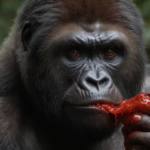Introduction to Orangutans
Orangutans are some of the most fascinating creatures on our planet. With their bright orange fur and intelligent eyes, these gentle giants captivate anyone who has the chance to observe them in their natural habitat. As one of our closest relatives in the animal kingdom, understanding what they eat offers a glimpse into their complex lives and behaviors. From lush rainforests to treetops filled with fruits, orangutans’ diets reflect their unique adaptations and environment. Have you ever wondered what do orangutans eat? Let’s dive into the dietary habits of both wild and baby orangutans to uncover the secrets behind their feeding choices!
The Diet of Wild Orangutans
Wild orangutans are primarily frugivorous, meaning fruit makes up the majority of their diet. They thrive on a variety of fruits, including durians, figs, and jackfruits. These foods provide essential energy for their active lifestyles.
In addition to fruit, they consume leaves, bark, flowers, and insects when necessary. This diverse menu helps them adapt to changing environments. Their foraging behavior showcases remarkable intelligence; they often use tools like sticks or branches to extract insects from tree crevices.
Orangutans spend most of their time high in the trees searching for food. Their strong arms allow them to swing effortlessly between branches while picking ripe fruits.
Seasonal changes affect what’s available too. During certain times of the year, specific fruits become scarce or abundant, influencing their feeding patterns significantly. Thus, wild orangutans showcase a beautifully complex relationship with their habitat through diet choices.
Feeding Habits and Behaviors of Baby Orangutans
Baby orangutans are incredibly curious and playful. Their natural instinct drives them to explore their surroundings while foraging for food. They spend hours swinging from branch to branch, practicing their climbing skills.
These young primates primarily rely on their mothers for sustenance during the early months of life. A mother’s milk provides essential nutrients, ensuring healthy growth and development. As they mature, they begin to sample solid foods alongside nursing.
Fruit is a favorite among baby orangutans. They particularly enjoy ripe figs, bananas, and mangos. Observing how they handle food can be fascinating; they often use both hands to grasp fruit or tear apart leaves.
Social learning plays a significant role in their feeding habits too. Young ones watch and imitate older orangutans as they navigate tree canopies in search of tasty treats, gradually honing their own techniques over time.
Differences in Diet Between Baby and Adult Orangutans
Baby orangutans have distinct dietary needs compared to their adult counterparts. While adults thrive on a varied diet rich in fruits, leaves, and bark, infants rely heavily on their mother’s milk during the first few months of life.
As they grow, baby orangutans begin experimenting with soft fruits and tender leaves. Their small teeth make it challenging to tackle tougher foods that adults consume without issue.
Adult orangutans can feast on harder nuts or fibrous plant material due to stronger jaws and more developed teeth. In contrast, babies need easily digestible options as they adapt to solid foods over time.
This gradual transition helps ensure young ones receive essential nutrients while learning about food sources in their natural habitat. It’s a delicate balance between nurturing instincts and the instinctual drive for exploration that defines an orangutan’s early years.
Nutritional Needs for Healthy Baby Orangutans
Baby orangutans have unique nutritional requirements that are crucial for their growth and development. Their diet primarily consists of fruits, which provide essential vitamins and minerals.
In the wild, they enjoy ripe figs, durian, and various berries. These fruits offer the necessary energy to support their active lifestyle as they explore their environment.
Besides fruit, young orangutans also need protein sources. In rehabilitation settings, caregivers supplement their diets with mashed vegetables and even small amounts of insects to mimic natural feeding habits.
Hydration is another key factor in maintaining health. Fresh water should always be available to ensure proper hydration throughout the day.
Understanding these needs helps foster healthy growth in baby orangutans while preparing them for life in the wild or suitable habitats post-rehabilitation. The right balance of nutrients plays a significant role in shaping strong future adults.
Rehabilitation and Release Programs for Baby Orangutans
Rehabilitation programs for baby orangutans play a crucial role in their survival. Many of these young primates become orphaned due to deforestation and illegal pet trade. Dedicated facilities provide them with the care they desperately need.
In these sanctuaries, caregivers mimic natural habitats. They ensure that each orangutan learns essential skills like climbing and foraging. This is pivotal for their eventual return to the wild.
These programs also promote socialization among the babies. Young orangutans benefit from interacting with peers as it fosters important behavioral traits critical for life in the wild.
Once they’re ready, rehabilitation centers prepare them for release into protected areas. Close monitoring continues post-release to assess how well they adapt back into their natural environment.
The commitment of organizations involved is vital not just for individual animals but also for preserving biodiversity and ecosystems where these magnificent creatures thrive.
Conclusion:
Understanding what orangutans eat provides insight into their unique role in the ecosystem. These remarkable creatures thrive on a diverse diet primarily consisting of fruits, leaves, and insects. Their feeding habits are fascinating, especially when examining baby orangutans.
Baby orangutans rely heavily on their mothers for nourishment during the earliest months of life. As they grow, they learn to forage and develop preferences based on their environment. The differences between the diets of babies and adults highlight the adaptability of these primates as they transition from milk-based nutrition to solid food.
The nutritional needs of young orangutans are critical for healthy growth and development. Ensuring that these babies receive proper care is vital, particularly in rehabilitation programs designed to support them before reentering their natural habitat.
With increasing awareness about conservation efforts, understanding how we can help protect both wild and rehabilitated orangutans becomes essential for sustaining their populations. Through education and advocacy, we can ensure future generations will continue to marvel at these incredible animals—preserving not just what do orangutans eat but also ensuring a thriving existence in the wild.


